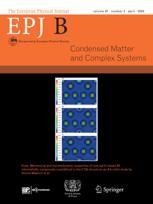How a transparent conductor responds to strain
First-principles calculations show how to manipulate some transition metal oxides’ optical and electronic properties for use in thin-film devices.
New York | Heidelberg, 2 August 2023
 Liquid crystal displays, touchscreens, and many solar cells rely on thin-film crystalline materials that are both electrically conductive and optically transparent. But the material most widely used in these applications, indium tin oxide (ITO), is brittle and susceptible to cracking. Researchers seeking alternatives have set their sights on strontium vanadate (SrVO3), a material that ticks all the boxes for a transparent conductor. In a study published in EPJ B, Debolina Misra, of the Indian Institute of Information Technology, Design and Manufacturing, Kancheepuram, India, and her colleagues now calculate how SrVO3‘s optical and electron transport properties vary in response to strain. Their simulations provide a detailed mechanism for tuning these properties to optimize the material’s utility in different devices and applications.
Liquid crystal displays, touchscreens, and many solar cells rely on thin-film crystalline materials that are both electrically conductive and optically transparent. But the material most widely used in these applications, indium tin oxide (ITO), is brittle and susceptible to cracking. Researchers seeking alternatives have set their sights on strontium vanadate (SrVO3), a material that ticks all the boxes for a transparent conductor. In a study published in EPJ B, Debolina Misra, of the Indian Institute of Information Technology, Design and Manufacturing, Kancheepuram, India, and her colleagues now calculate how SrVO3‘s optical and electron transport properties vary in response to strain. Their simulations provide a detailed mechanism for tuning these properties to optimize the material’s utility in different devices and applications.
Strontium vanadate belongs to a class of materials called correlated oxides, whose remarkable magnetic, electronic, optical, ferroelectric, and piezoelectric properties have long attracted attention. It stands out due to its extremely high concentration of electrons along with its thermal stability and optical transparency. For correlated oxides including SrVO3, stretching and squeezing the crystal form can induce changes in how electrons interact with each other, leading to subtle changes in structure and functionality.
Various experiments and theoretical studies have already shown how strain can impact the transport properties of bulk and thin film SrVO3. To identify the precise changes that occur in the thin film version, Misra and her colleagues employed first-principles calculations to simulate the material’s physical properties from basic quantum mechanical considerations. Their simulations showed how the material’s electronic band structures change under compressive and tensile strains.
The researchers found that tensile strain resulted in a less-conducting state and an increased optical transparency window. In contrast, compressive strain made the material act as a better conductor, with a decreased window for optical transparency. The results provide insight into how to control the electronic correlations in SrVO3 to maximize its utility as a transparent conductor.
Reference: Biswas, M., Misra, D. & Kundu, T.K. Strain induced variations in transport and optical properties of SrVO3: a DFT + U study. Eur. Phys. J. B 96:74 (2023). https://doi.org/10.1140/epjb/s10051-023-00547-6
Further Information
For more information visit: www.epj.org
Services for Journalists
The full-text article is available here.
Contact
Sabine Lehr | Springer | Physics Editorial Department
tel +49-6221-487-8336 | sabine.lehr@springer.com
